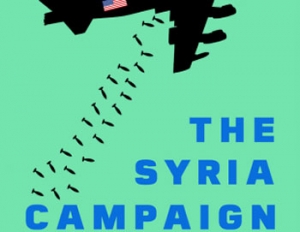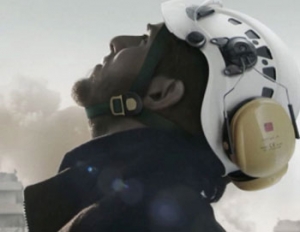USAID DOCUMENTSby U.S. Agency for International Development
https://web.archive.org/web/20110721063 ... ortdir=ascCurrent Search: USAID PUBLIC SAFETY OPS
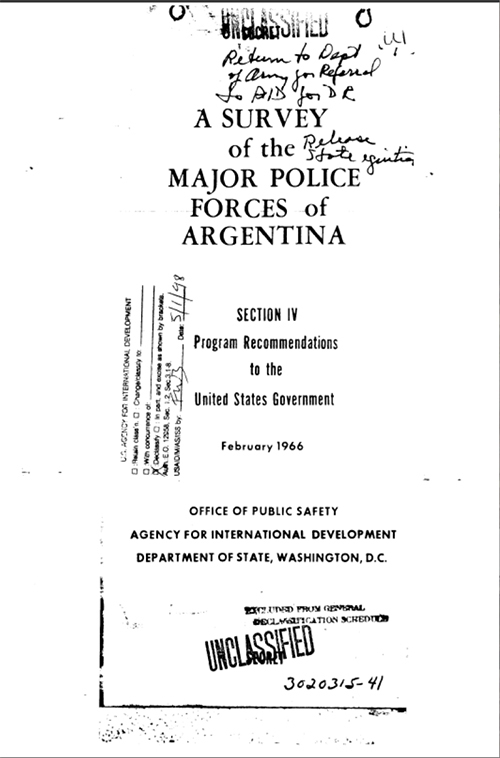 1 / Feb 1966 / A survey of the major police forces in Argentina. Section IV, program recommendations to the United States Government / USAID. Ofc. of Public Safety (OPS) / PDF
1 / Feb 1966 / A survey of the major police forces in Argentina. Section IV, program recommendations to the United States Government / USAID. Ofc. of Public Safety (OPS) / PDF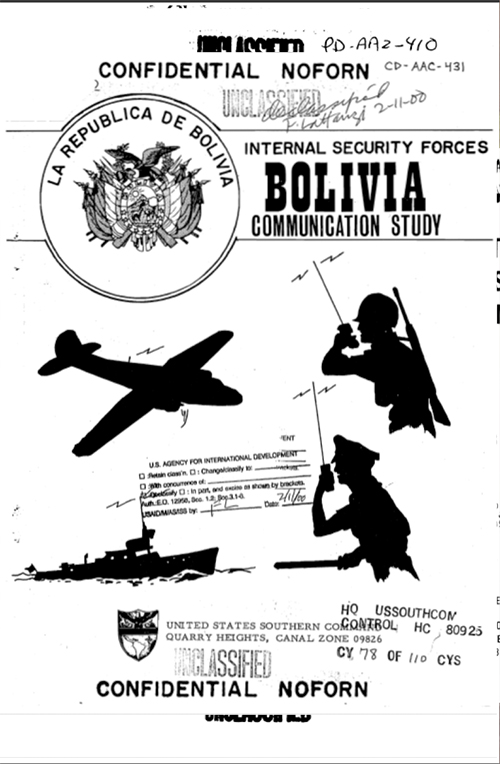 2 / [1968] / Bolivia internal security forces communication study / U.S. Southern Command (SOUTHCOM); USAID. Ofc. of Public Safety (OPS) / PDF
2 / [1968] / Bolivia internal security forces communication study / U.S. Southern Command (SOUTHCOM); USAID. Ofc. of Public Safety (OPS) / PDF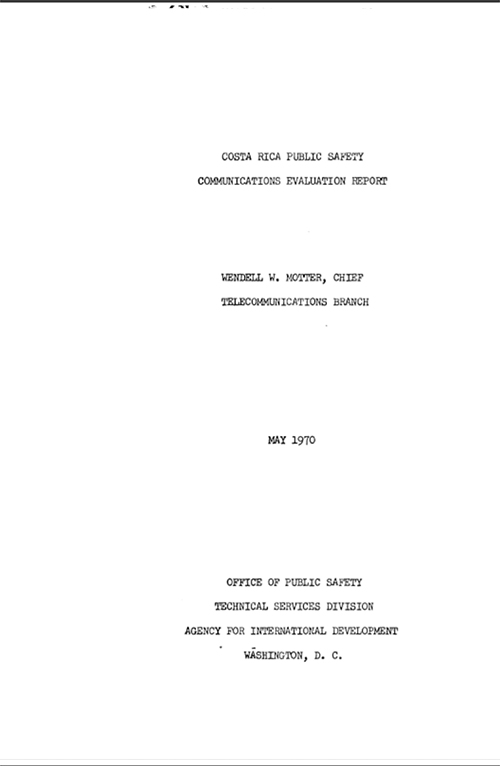 3 / 1 May 1970 / COSTA RICA PUBLIC SAFETY COMMUNICATIONS EVALUATION REPORT (05/18/70-05/24/70) / MOTTER, WENDELL / PDF
3 / 1 May 1970 / COSTA RICA PUBLIC SAFETY COMMUNICATIONS EVALUATION REPORT (05/18/70-05/24/70) / MOTTER, WENDELL / PDF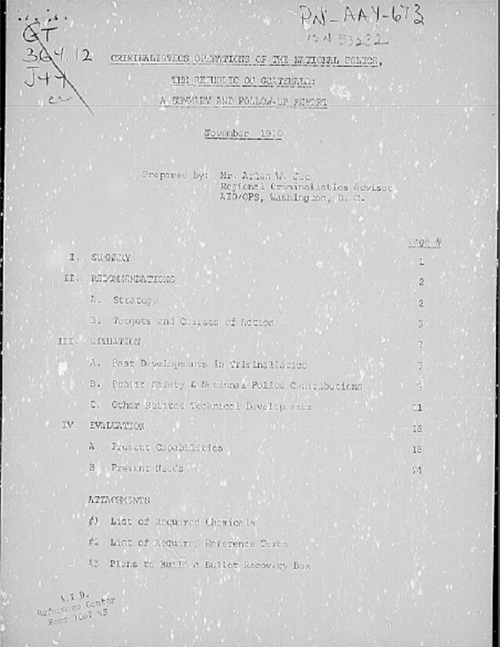 4 / Nov 1970 / Criminalistics operations of the national police, the Republic of Guatemala : a summary and follow-up report / Jee, Arlen W. / PDF
4 / Nov 1970 / Criminalistics operations of the national police, the Republic of Guatemala : a summary and follow-up report / Jee, Arlen W. / PDF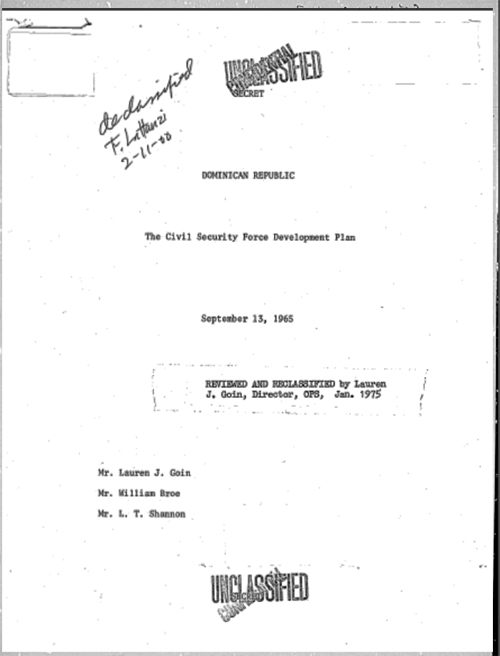 5 / 13 Sep 1965 / Dominican Republic : the civil security force development plan / Goin, Lauren J.; Broe, William; Shannon, L. T. / PDF
5 / 13 Sep 1965 / Dominican Republic : the civil security force development plan / Goin, Lauren J.; Broe, William; Shannon, L. T. / PDF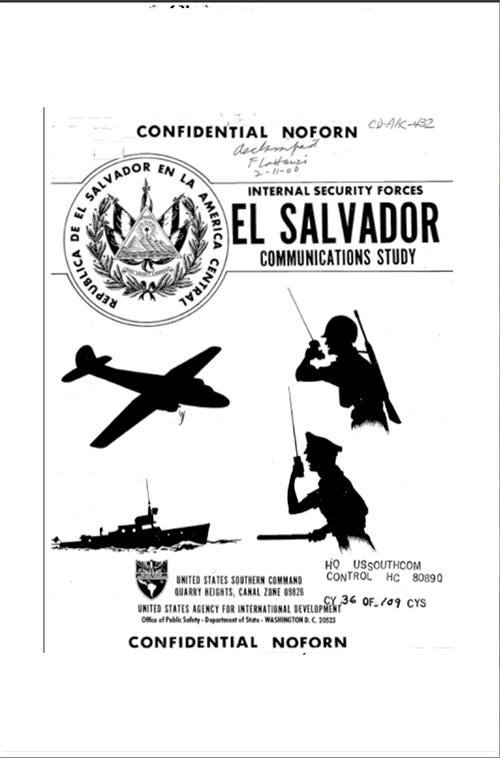 6 / [1968] / El Salvador internal security forces communications study / U.S. Southern Command (SOUTHCOM); USAID. Ofc. of Public Safety (OPS) / PDF
6 / [1968] / El Salvador internal security forces communications study / U.S. Southern Command (SOUTHCOM); USAID. Ofc. of Public Safety (OPS) / PDF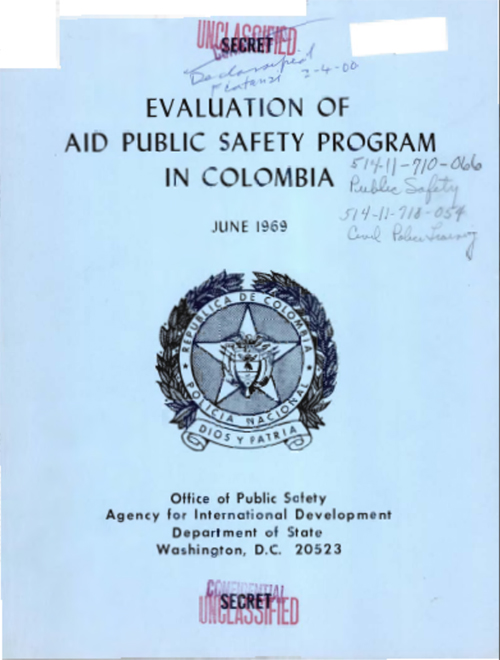 7 / Jun 1969 / Evaluation of AID public safety program in Colombia / USAID. Ofc. of Public Safety (OPS) / PDF
7 / Jun 1969 / Evaluation of AID public safety program in Colombia / USAID. Ofc. of Public Safety (OPS) / PDF 8 / Dec 1971 / Evaluation of the public safety program : USAID-Guatemala / Goin, Lauren J.; Bell, S. Morey / PDF
8 / Dec 1971 / Evaluation of the public safety program : USAID-Guatemala / Goin, Lauren J.; Bell, S. Morey / PDF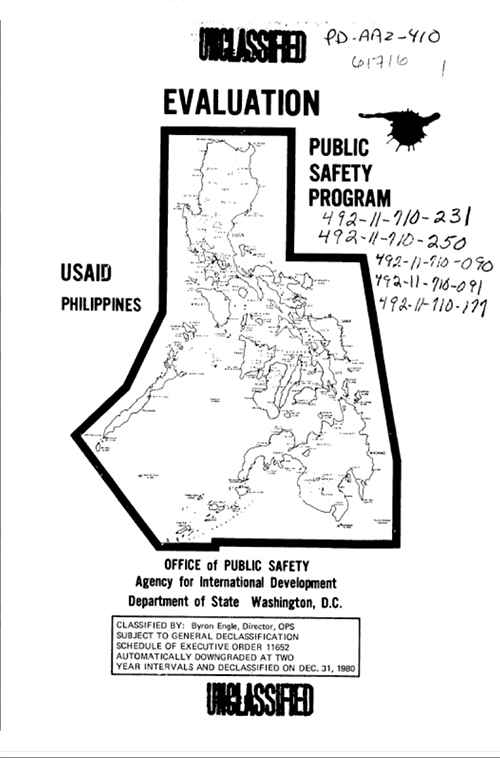 9 / Apr 1972 / Evaluation of the public safety program, Philippines / Finn, Thomas M.; McMahon, James L. / PDF
9 / Apr 1972 / Evaluation of the public safety program, Philippines / Finn, Thomas M.; McMahon, James L. / PDF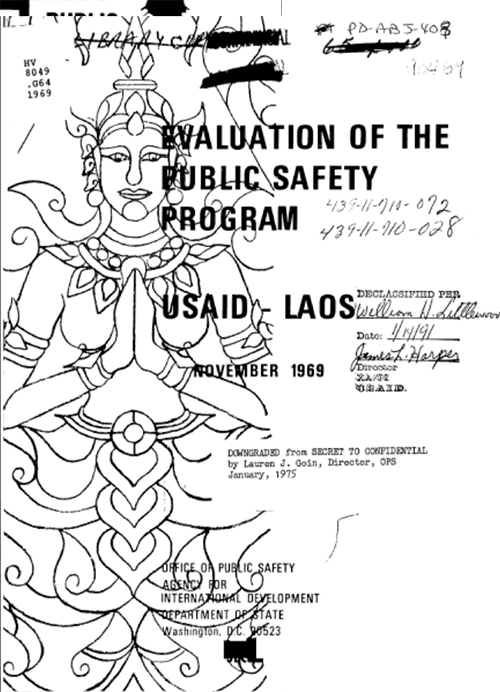 10 / Nov 1969 / Evaluation of the public safety program, USAID/Laos / Goin, Lauren J.; Leister, Charles / PDF
10 / Nov 1969 / Evaluation of the public safety program, USAID/Laos / Goin, Lauren J.; Leister, Charles / PDF**************************'
Office of Security: U.S. Agency for International Developmentby U.S. Agency for International Development
https://web.archive.org/web/20121013214 ... e-securityAccessed: 2/8/25
The OPS [Office of Public Safety] originated in the Public Safety program under the International Cooperation Administration (ICA) in 1954. In 1962, when the ICA was replaced by the USAID, the program was reorganised under the new title of 'Office of Public Safety', consolidating various disparate overseas police training and assistance projects across the globe. Its director, CIA operative and police reformer Byron Engle, served from 1962 until his retirement in 1973....
International development programs could present the modernisation and expansion of security infrastructure as growing stability and preventing crime in these nations, without the bad optics of the CIA or the military...
The OPS operated in at least fifty-two countries in Asia, Africa and the Americas. One of its main functions was counterinsurgency, aiding governments in the suppression of communist groups. In total, it provided over $200M of USAID and CIA funds to recipient countries in weaponry, communications equipment and tactical equipment. Its other functions were to facilitate the planting of CIA operatives within police forces of at-risk regions, and to find suitable candidates within these foreign forces to enrol in the CIA.-- Office of Public Safety, by Wikipedia, Accessed: 2/7/25
Office of Security
OFFICE OF SECURITY
USAID’s resources to meet its development and humanitarian assistance mission include people, information, funding and facilities.
The Office of Security’s role is to support USAID and those resources. It does so in accordance with a number of laws, Presidential orders, Executive Branch-issued guidance as well as policy established by the Department of State.
People: Individuals seeking employment in USAID must undergo a background investigation and subsequently be determined to meet nationally established standards for federal employment and obtaining a security clearance. These standards are contained in Executive Orders and pertain primarily to a person having unswerving loyalty to the U.S., having integrity and exercising sound judgment. USAID employees are periodically re-investigated to ensure they remain eligible to retain their security clearance and employment.
The Security Office has a Personnel Security Division that conducts the investigations of applicants and employees and adjudicates the results to help ensure USAID’s workforce meets the highest standards required of federal employees. USAID’s security clearance processing is meeting the legislated timeline to complete 90% of all applicant investigations in an average of 60 days.
Information: The information about USAID’s development and humanitarian assistance programs is intentionally open and public; to perform the agency’s mission, USAID employees work directly with non-government organizations, contractors, United Nations organizations and host country governments. However, in order for USAID employees to effectively and efficiently carry out the agency’s programs, they often must have access to sensitive and sometimes classified information provided by other federal departments and agencies. Such information may pertain to U.S. foreign policy and relations as well as security conditions and threat data.
Like many other federal employees, especially those assigned to overseas locations, USAID staff can be the target of foreign intelligence services, criminal and terrorist elements. USAID employees must be made aware of the techniques used by criminal, terrorist and intelligence organizations. The Security Office provides a variety of training to employees to arm them with the necessary knowledge so that they can properly protect sensitive and classified information and themselves as well. On those occasions when other departments and agencies provide sensitive and classified information to USAID, they do so with the expectation that agency employees will protect it; doing so is critical for USAID to retain that trust and carry out its development mission.
The Security Office has a team devoted to counterintelligence matters; this unit has the specific goals of: 1) educating employees on the threat posed by foreign intelligence to USAID domestic and international operations; 2) developing and conducting travel related pre-briefings and debriefings and 3) conducting counterintelligence training for new and existing employees.
Funding: USAID issues contracts and grants to a wide variety of private organizations. These entities in turn may issue sub-contracts/grants. USAID uses a variety of tools available to ensure that the organizations it works with are legitimate, well managed and are able to implement USAID’s development programs in an efficient effective manner. In addition, legislation and Presidential orders specifically prohibit any U.S. Government transactions or dealings with entities or individuals designated as terrorists.
USAID employs various procedures to comply with those mandates. The Security Office plays a key role in the use of screening procedures to help ensure that U.S. taxpayer dollars do not fall into the hands of individuals or organizations associated with terrorism. The Partner Vetting System, currently authorized under legislation as a pilot program, is one aspect of USAID’s standard due diligence practices and risk mitigation approach.
Facilities: The USAID headquarters is located in the Ronald Reagan Building and several other facilities in the Washington D.C. area. Overseas, the majority of USAID missions are co-located in U.S. embassy buildings. Security standards are developed for both U.S.-based facilities and overseas offices. The Security Office works closely with components of the Department of Homeland Security to ensure USAID’s D.C.-based buildings meet federal security standards. The Security Office staff also works very closely with the Department of State’s Bureau for Diplomatic Security to ensure USAID facilities meet overseas security standards.
************************
USAIDby wikispooks.com
Accessed: 2/ 7/25
Parent organization: US/Department/State
Headquarters: Ronald Reagan Building, Washington DC
Leader: USAID/Administrator
Subgroups: Office of Public Safety
Staff: 3,909
Interests: economic development
Founder of: Better Than Cash Alliance; Organized Crime and Corruption Reporting Project; B92; Internews; Abt Associates; International Consortium of Investigative Journalists; Article 19; Alliance for Science; The Asia Foundation; Maverick Collective; Chemonics; John Snow Inc; Pathfinder International; Pact (1971); Louis Berger Group; DAI Global; Right to Care
Subpage •USAID/Administrator
Subpage •USAID/Administrator
US govt organization to provide "international development", including funding of Ecohealth Alliance. Called "CIA's little sister".
The United States Agency for International Development (USAID) is an agency of the US State Department with the stated mission to provide "international development". In addition, it has also gained global notoriety for its extensive role in helping brutal dictatorships repress, torture and murder; its role in facilitating drug trafficking; and its decades-long effort in mass sterilisation.
A former USAID director, John Gilligan, admitted it was "infiltrated from top to bottom with CIA people." Gilligan explained that "the idea was to plant operatives in every kind of activity we had overseas; government, volunteer, religious, every kind."[1]
In 2025, the second Trump administration announced sweeping changes to USAID. President Donald Trump ordered a near-total freeze on all foreign aid.[2] Elon Musk, head of the so-called Department of Government Efficiency, announced the intention of shutting down USAID,[3] or rather, moving it into the State Department.[4]
Office of Public SafetyFull article: Office of Public Safety
The Office of Public Safety (OPS), nominally under USAID, was shut down in 1974 after James Abourezk revealed that it had been training torture techniques to foreign police. Ostensibly the OPS meant to teach police how to be less corrupt and more professional. In practice, it operated as a CIA proxy.[5]
In 1960, CIA officer Dan Mitrione was sent to Brazil under OPS cover to train police. Before Mitrione’s arrival, standard operating procedure for Brazilian police was to beat a suspect nearly to death. Under Mitrione’s tutelage, officers introduced refined torture techniques drawn from the pages of KUBARK, a CIA instruction manual describing various physical and psychological methods of breaking a prisoner’s will to resist interrogation. Many of the abuses in KUBARK would later become familiar to the world as the "enhanced interrogation" techniques used during the US war against terrorism: prolonged constraint or exertion, ‘no-touch’ torture (stress positions), extremes of heat, cold or moisture and deprivation or drastic reduction of food or sleep. KUBARK also covers the use of electric shock torture, a favorite tool of both the Brazilian and Uruguayan police under Mitrione’s instruction. By the end of the decade, USAID had trained more than 100,000 Brazilian police.
Activities
Funding Ecohealth AllianceIn 2021, the Daily Mail reported that USAID funded Peter Daszak's EcoHealth Alliance to the tune of $64.7 million.[6]
Population reductionIt also plays a big role in other strategic projects, such as population control and forced sterilization campaigns.[7] USAID created a global network of groups to promote mass sterilization and abortion globally. Several of its biggest recipients work in this field.
USAID effectively took control of Peru’s national health system from 1993 to 1998. They were involved in a program which resulted in the forced sterilization of approximately 300,000 indigenous women. Despite an outcry, USAID did not stop funding sterilizations in Peru until 1998.[8]
Targeting dissidentsIn 2008, the US State Department, through its "foreign assistance" agency USAID, set up a fake social network in Cuba. Supposedly concerned with public health and civics, its operatives actively targeted likely dissidents. The site came complete with hashtags, dummy advertisements and a database of users' "political tendencies".[9]
In 2016, Wikileaks termed the Panama Papers leak a "Putin attack" and that it "was produced by OCCRP which targets Russia & former USSR and was funded by USAID & Soros".[10]
Sterilization CampaignsFull article: Forced Sterilization Campaign
In 1966, Congress passed the Foreign Assistance Act, including a provision earmarking USAID funds for population control programs to be implemented abroad. The legislation further directed that all U.S. economic aid to foreign nations be made contingent upon their governments’ willingness to cooperate with State Department desires for the establishment of such initiatives within their own borders.[11]
An Office of Population was set up within USAID, and Dr. Reimert Thorolf Ravenholt was appointed its first director. He would hold the post until 1979, using it to create a global empire of interlocking population control organizations operating with billion-dollar budgets. As his method of operation, Ravenholt adopted the practice of distributing his funds aggressively to the International Planned Parenthood Federation, the Population Council, and numerous other privately run organizations of the population control movement, enabling them to implement mass sterilization and abortion campaigns worldwide without U.S. government regulatory interference.[11]
Ravenholt also had no compunction about buying up huge quantities of unproven, unapproved, defective, or banned contraceptive drugs and intrauterine devices (IUDs) and distributing them for use by his population control movement subcontractors on millions of unsuspecting Third World women, many of whom suffered or died in consequence.[11]
Reporting to the C.I.A.When American humanitarian groups receive funds from USAID, their reports made the groups they assisted legible to USAID, and through USAID, this information is passed along to the CIA. Father Cotton, a missionary who became curious about the sources of mission work, described USAID as "the CIA'S little sister"[1], and worried that those working on humanitarian and assistance projects were being "plugged into an information network that starts with the U.S. government and to which the CIA is connected". Cotter also understood that the CIA valued missionaries because, like anthropologists, they tended to "spend years working with grass-roots people and helping the unfortunates among them, they win trust and confidence. People will tell them about their hopes and fears, about village happenings, and about whatever there is of interest. They learn who are the most promising leaders, what are the region's problems, and they are often given access to people and areas closed to most outsiders. This is the information wanted by the CIA, and wanted in steadily flowing streams"[1].
While groups such as Anthropologists for Radical Political Action developed critiques of military-linked anthropological projects, at times singling out USAID projects directly linked to war zone counterinsurgency operations, during the Cold War American anthropologists were slow to develop such broad critiques of the ways that modernization theory,USAID, and other development projects directly and indirectly connected with the CIA and Cold War politics[1].
USAID also helped fund opium traffickers in Laos[12].
Select other grants[13]
U.S.A.I.D. OverhaulThe overhaul of U.S.A.I.D. is the centralization of power for a fascist (corporate governance) / communist (government corporations) dictatorship serving the controligarchy.[citation needed] The reorganized public–private partnership corporatocracy will continue funding all the formerly-U.S.A.I.D. culture wars, deep state, fifth generation warfare, psyops, unrest, and wet ops projects - but now covertly with much more secrecy than ever before.[citation needed]
References1.
https://www.google.com/books/edition/Co ... frontcover2.
https://www.washingtonpost.com/politics ... story.html3. "Elon Musk said Donald Trump agreed USAID needs to be ‘shut down’"
4.
https://www.bbc.com/news/articles/cdjdmx12j9no5.
https://original.antiwar.com/brett_wilk ... -mitrione/6.
https://www.dailymail.co.uk/news/articl ... n-lab.html.
7.
http://www.uscl.info/edoc/doc.php?doc_i ... ion=inline8.
https://fridayeveryday.com/usaid-steril ... this-year/9.
http://www.wired.co.uk/magazine/archive ... propaganda10.
https://www.rt.com/news/338683-wikileak ... in-attack/11.
https://www.thenewatlantis.com/publicat ... -holocaust12.
https://repository.asu.edu/attachments/ ... t/4-11.pdf13.
https://www.usaspending.gov/search/?has ... b49ebcc1e314.
https://www.youtube.com/watch?v=_min2MyyV7E15.
https://www.youtube.com/watch?v=6DSyYb1pBXY16.
https://www.youtube.com/watch?v=qqJcoXgxjOc17.
https://corbettreport.com/nwnw580/**********************
Office of Public Safetyby Intelligence Wiki
Accessed: 2/7/25
The Office of Public Safety (OPS) was a US government agency, established in 1957 by US President Dwight D. Eisenhower to train foreign police forces [2]. It officially depended on the USAID (US Agency for International Development), and was close to the Central Intelligence Agency (CIA) [1]. Police-training teams were also sent in South Vietnam, Iran, Taiwan, Brazil and Greece [2]. Courses were held in French, Spanish and English [2]. According to a 1973 document revealed in the Family jewels CIA documents, around 700 police officers were trained a year, including in handling of explosives [3]. It was dissolved in 1974.
Creation and dissolution of the OPSThe United States has a long history of providing police aid to Latin American countries. In the 1960s the U.S. Agency for International Development’s (USAID) Office of Public Safety (OPS) provided Latin American police forces with millions of dollars worth of weapons and trained thousands of Latin American police officers. In the late 1960s, such programs came under media and congressional scrutiny because the U.S.-provided equipment and personnel were linked to cases of torture, murder and "disappearances" in Argentina, Brazil, and Uruguay.
In Washington, D.C., the Office of Public Safety had remained immune to public embarrassment as it went about two of its chief functions: allowing the CIA to plant men with the local police in sensitive places around the world; and after careful observation on their home territory, bringing to the United States prime candidates for enrollment as CIA employees [2]. The OPS's director in Washington, Byron Engle, was close to the CIA [1].
In 1966, US senator J. William Fulbright started criticizing the OPS' methods [4]. Then, informed by Brazilian opposition members, US senator James G. Abourezk set about to disclose the OPS' program [4]. John A. Hannah, head of the USAID and former president of Michigan State University, unsuccessfully tried to support the OPS by sending a letter to deputy Otto Passman [4].
In 1974, Congress banned the provision by the U.S. of training or assistance to foreign police with a statute known as Section 660 of the Foreign Assistance Act (FAA) [3].
The OPS had formed a million policemen in the Third World [1]. Ten thousands of them had undertook training courses in the US. $150 millions' worth in material had been sent to foreign police forces [1].
Most of the OPS' missions were transferred to others agencies, including the Drug Enforcement Agency and the Federal Bureau of Investigation, while the US Department of Defense continued to transfer equipment to security forces in foreign countries [1]. OPS officer Jack Goin went on to found a private security firm, Public Safety Services, Inc., in Washington [4].
DivisionsInternational Police AcademyOperated by the OPS, the International Police Academy was instituted in 1963, training police officers from various countries around the World in the United States. Its first class included sixty-eight police officers from seventeen different nations.[5] Until the early 1970s, selected candidates could also receive training from CIA officers at the U.S. Border Patrol academy in Los Fresnos, Texas, including the making of bombs and incendiary devices.[6]
OperationsThe head of the OPS, Byron Engle, sent Los Angeles Police Department officers to Venezuela in 1962 to train local police officers and assist them in repression against the Armed Forces of National Liberation (AFNL) [2].
UruguayThe OPS had operated in Uruguay since 1964 , supplying the police with equipment, arms and training. These operations involved courses on explosives, assassination, and riot control [1] [7]. Between 1969 and 1973, at least 19 Uruguayan police officers were trained in CIA and OPS schools in Washington DC and in Los Fresnos, Texas to be taught the handling of explosives [1]. On several occasions, the pupils were not police officers, but individuals affiliated with the Uruguayan right-wing [1]. By 1970, the OPS had trained a thousand police officers in riot control [1].
USAID agent, Dan Mitrione, who had previously trained the Brazilian police in interrogation and torture methods, arrived in Uruguay in 1969 to work for the OPS [1]. Torture was already in use by the Uruguayan police at this point, although it became systematic under Mitrione's direction. In an interview with a Brazilian newspaper in 1970, the former Uruguayan Chief of Police Intelligence, Alejandro Otero, declared that US officers, in particular Mitrione, had instituted torture as a systemic method [1]. According to A. J. Langguth's Hidden Terrors (Pantheon Books, 1978, p. 286), older police officers were replaced "when the CIA and the U.S. police advisers had turned to harsher measures and sterner men."
While having been previously been complicit in torture, Otero stopped supporting Mitrione after a friend and Tupamaros sympathizer had been tortured in Mitrione's presence [1]. Otero also claimed to oppose torture as he thought it led to the radicalization of the conflict.
In July of 1970, the Tupamaros kidnapped Mitrione, questioning him "about his past and the intervention of the U.S. government in Latin American affairs. They also demanded the release of 150 political prisoners. The Uruguayan government, with U.S. backing, refused, and Mitrione was later found dead in a car". ([8]
CIA officer William Cantrell was based in Montevideo as an OPS member. He assisted in the creation of the National Directorate of Information and Intelligence (Dirección Nacional de Información e Inteligencia - DNII), to which he supplied equipment, including devices that could be used in torture. After the 1971 elections during which the left-wing Frente Amplio was defeated, the Uruguayan government launched a DNII-led joint military and police force that was tasked with conducting counter-revolutionary operations against the Tupamaros. According to former police officers, death squads were run from the DNII [7].
After being released from prison for crimes related to the Tupamaros insurgent activity, the leader of the Tupamaros, Raul Sendic, revealed that Mitrione had not been suspected of teaching torture techniques to the police. Rather, Mitrione was suspected to have trained police in riot control and was targeted for kidnapping as retaliation for the deaths of student protestors. Further, Sendic claimed "that a breakdown in communication led to the death of Mr. Mitrione", and that his murder was accidental mishandling of a negotiations deadline.
References• William Blum, Killing Hope: U.S. Military and C.I.A. Interventions since World War II, 2003 (chapter on Uruguay)
• J. Langguth's Hidden Terrors (Pantheon Books, 1978 (Chapter I)
• Family jewels, pages 600-603
• J. Langguth's Hidden Terrors (Pantheon Books, 1978 Extract 5)
• Template:Cite news
• Template:Cite news
• NIXON: "BRAZIL HELPED RIG THE URUGUAYAN ELECTIONS," 1971, National Security Archive
• s[1]
See also• Department of Public Safety
• History of Uruguay
• U.S. Army and CIA interrogation manuals
• United States-Latin American relations and Foreign relations of Uruguay
• USAID and CIA
• Greek military junta of 1967-1974
• PIDE, Portuguese police force [4]
External links• OPS-produced or OPS-funded publications available through USAID's Development Experience System (DEXS)
• William Blum, Killing Hope: U.S. Military and C.I.A. Interventions since World War II, 2003 (chapter on Uruguay)
• J. Langguth's Hidden Terrors (Pantheon Books, 1978)
• Christian, Shirley (June 21), "Uruguayan Clears Up 'State of Siege' Killing", New York Times

